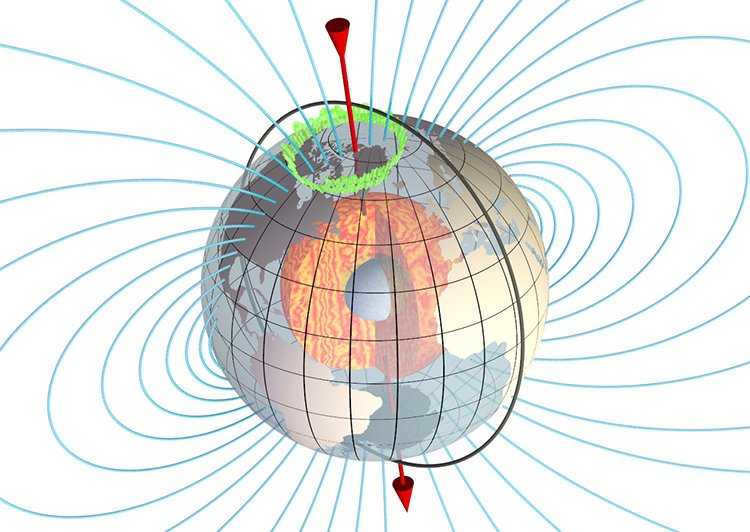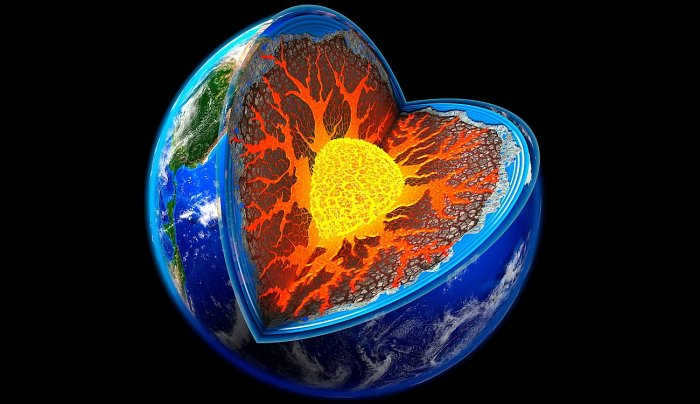

When it comes to its dimensions, the Earth appears relatively unassuming. Among its closest celestial neighbors in the Solar System, it is considered “average” in size, not even ranking among the top three. It is, in fact, the fourth largest out of eight. However, the true uniqueness of our planet lies not in its mass or the incredibly high temperatures within its core. Rather, it is the only known ecosystem that has served as the cradle for human civilization.
The Composition of the Earth
The Earth is approximately spherical in shape, with equatorial and polar diameters measuring 12,754 and 12,711 kilometers, respectively. If we were to mentally slice the Earth from its surface to its center, we would observe a layered structure similar to a “layer cake”. The Earth’s crust, which is up to 75 kilometers thick, forms the outermost layer. Beneath the crust lies the mantle, with an approximate thickness of 2,800 kilometers. Lastly, the core of the Earth is divided into two parts: the outer core, measuring 2,300 kilometers in thickness, and the inner core, which is approximately 1,200 kilometers thick.
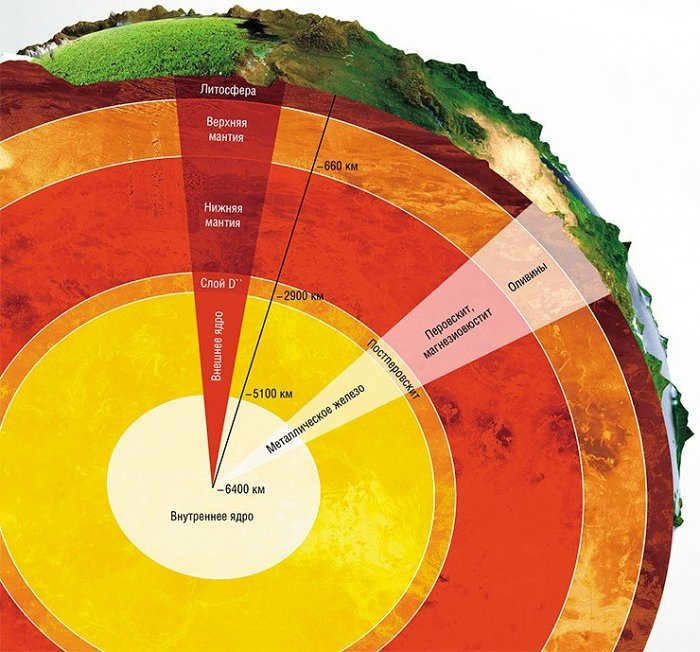
The Composition of the Planet Earth
However, the Earth’s structure is not limited to its solid core. The atmosphere, which extends into the sky, plays a crucial role in shaping the planet as we know it.
The atmosphere can be compared to a layer cake, but this time it is heavenly. The lower part of the atmosphere, known as the troposphere, stretches up to approximately 20 km. Above that, we have the stratosphere, which reaches up to 50 km. Beyond that, the mesosphere acts as an “anteroom” to near space. The thermosphere, which is considered the near space, extends from 80 to 700 km. Finally, we have the exosphere, the boundary of the Earth’s atmosphere, which we would need to travel 10,000 km to reach.
The Earth’s core has been the subject of fascinating scientific research. In 1897, the German geophysicist Emil Wichert put forth the hypothesis of its existence, marking a significant milestone in our understanding of the planet.

Emil Wichert, a geophysicist, made an interesting discovery during his research. He found that the Earth is composed of multiple layers, and the difference in density between the surface layer rocks and the average density of the Earth suggests the existence of a dense iron core at its center.
Almost three decades later, another geophysicist named Benoit de Libriz made a significant observation. Through measurements of earthquakes recorded 800 km from the epicenter, he noticed that seismic waves traveled faster than originally expected. This led him to conclude that there is a layer deep within the Earth that accelerates the propagation of waves.
Later, David Pipes, a British geophysicist who worked with Libriz, made a groundbreaking discovery. He found that Z-waves have the ability to travel through various types of media, including both solid and liquid substances. This includes the Earth’s core.
Understanding the Solid Earth’s Core
Further research and analysis by scientists have allowed them to determine the temperature of the Earth’s core. It ranges from 5427 to 5927 °C, which is roughly similar to the average temperature on the surface of the Sun (approximately 5500 °C) and even slightly higher. Interestingly, this temperature is higher than the temperature of plasma in the dark spots on the Sun, which is only 3727 °C.
What causes this phenomenon? The reason is that the Earth’s center functions as a one-of-a-kind natural reactor, with its core experiencing an immense amount of pressure – 350 gigapascals or 3.5 million atmospheres. This pressure is responsible for maintaining the solid crystal structure of the iron-nickel core and providing its rigidity. In contrast to the inner core, the outer core of the Earth is in a liquid state.
Reasons for the Elevated Temperature of the Earth’s Core
In recent years, there has been a notable scientific endeavor focused on attaining controlled thermonuclear fusion, with the ultimate goal of recreating the intense heat and energy of the sun. However, unbeknownst to many, a naturally occurring nuclear reactor exists right beneath our very feet, approximately 7000 kilometers below the Earth’s surface.
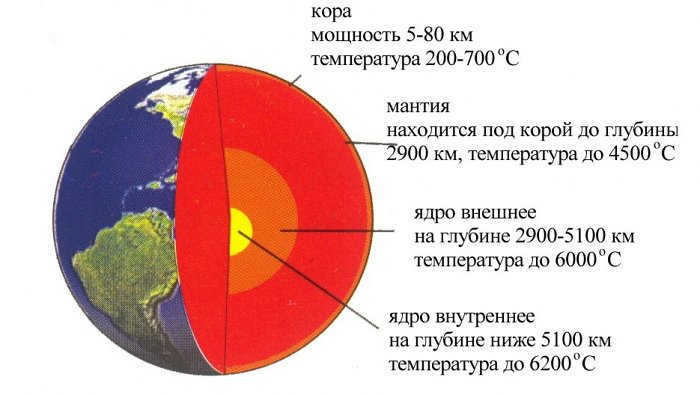

The Earth’s core temperature
It was formed approximately 4.5 billion years ago during the planet’s creation. However, this extensive duration has had minimal impact on the amount of heat emitted by the Earth’s core – nuclear decay within it continues to generate energy at a rate of up to 20 terawatts or 20 billion kW⋅h.
Nevertheless, the Earth’s reactor is gradually cooling down – at a rate of approximately 100 °C per billion years. Simultaneously, the loss of primary heat is partly compensated for by energy from friction and thermonuclear reactions, which hinder the natural cooling processes.
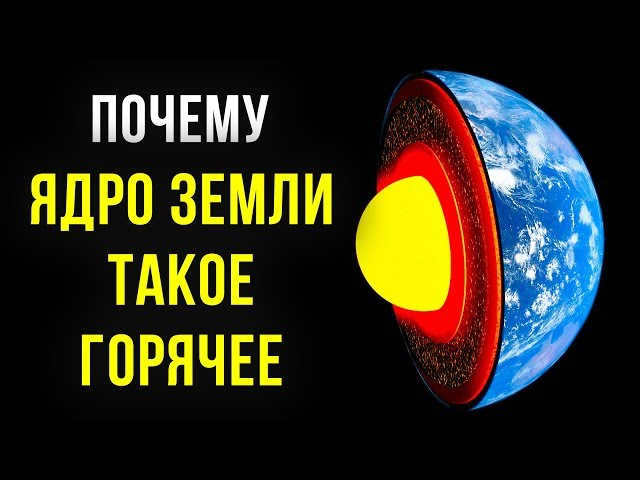

Did you enjoy reading the article? Do you have any thoughts to share? Come and join us:
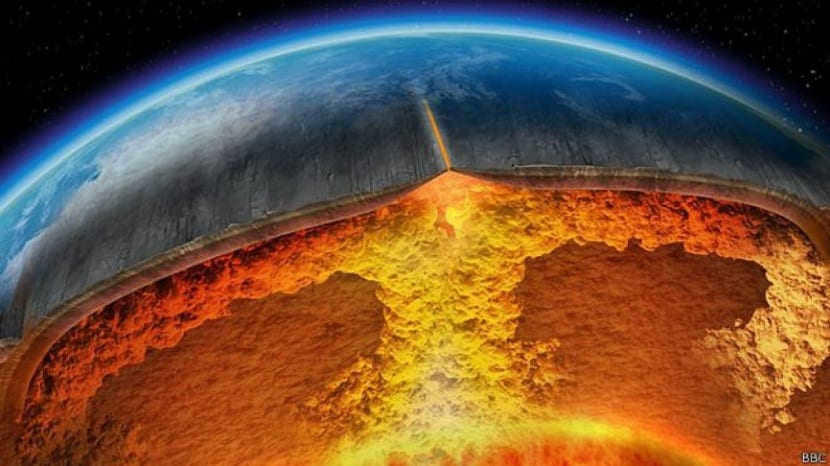

The Earth’s core, also known as the endosphere, is the innermost layer of the planet. It is a highly heated mass located at the very center of the planet’s interior. Comprised of both a solid inner core and a liquid outer core, the core plays a crucial role in the formation and maintenance of the Earth’s magnetic field, thanks to convection currents that arise from differences in material density.
This article provides a comprehensive analysis of the Earth’s core and its significance.
Origin and formation
The origin and formation of something refers to its beginnings and how it came to be. It is the process by which something is created or developed.
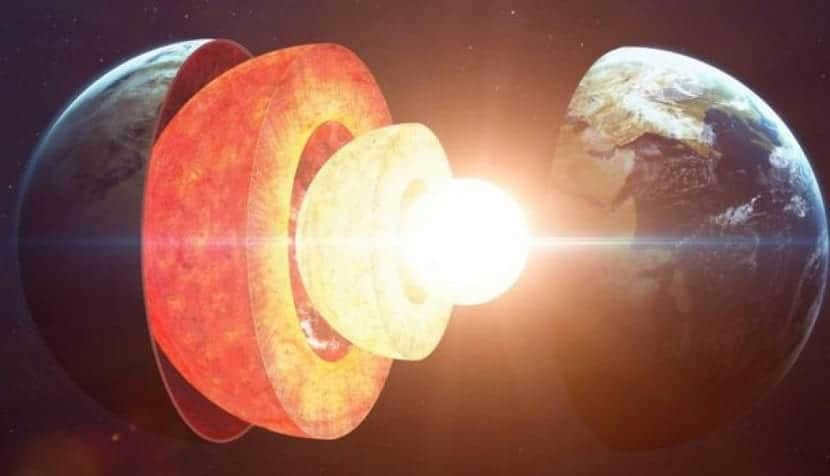
The Earth’s core was formed around 4.500 billion years ago, shortly after the planet itself. Initially, it existed as a uniform, glowing rock. Over time, it experienced radioactive decay and the intense heat from the planet’s formation, causing it to reach the melting point of iron. This pivotal moment is known as the iron catastrophe. As a result, the molten material within the rock and all other rocky substances became more mobile and gained greater velocity. The movement of less dense materials like water, air, and silicates led to the formation of the Earth’s mantle.
On the other hand, materials like iron, nickel, and various other heavy metals had the ability to draw in Earth’s gravitational force towards the center, resulting in the formation of the initial primitive core of the planet. This phenomenon is referred to as planetary differentiation, revealing the existence of diverse layers within the Earth with distinct characteristics and compositions.
The structure of the Earth’s core
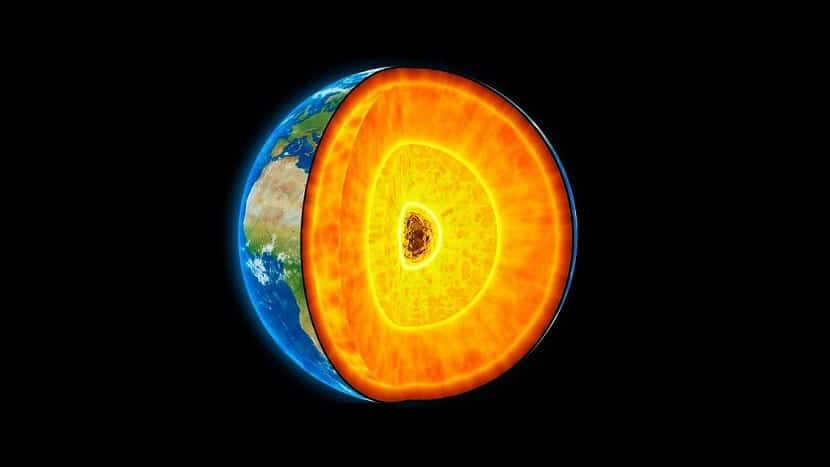

It is common knowledge that minerals are abundant in the Earth’s crust and mantle. However, the composition of the Earth’s core primarily consists of iron and nickel. Additionally, there are siderophiles, which are substances that can dissolve in iron. These elements, known as precious metals, are rare in the crust but can be found in the core. Among these precious metals are cobalt, gold, and platinum.
Due to the movement of convection currents, certain materials enter the core in a “fresh” state while others exit and no longer undergo melting. This phenomenon occurs as a result of the materials’ proximity or distance from the center, as well as their exceedingly high melting temperatures.
Research typically indicates that the Earth’s core is characterized by temperatures ranging from 4,000 to 6,000 degrees Celsius.
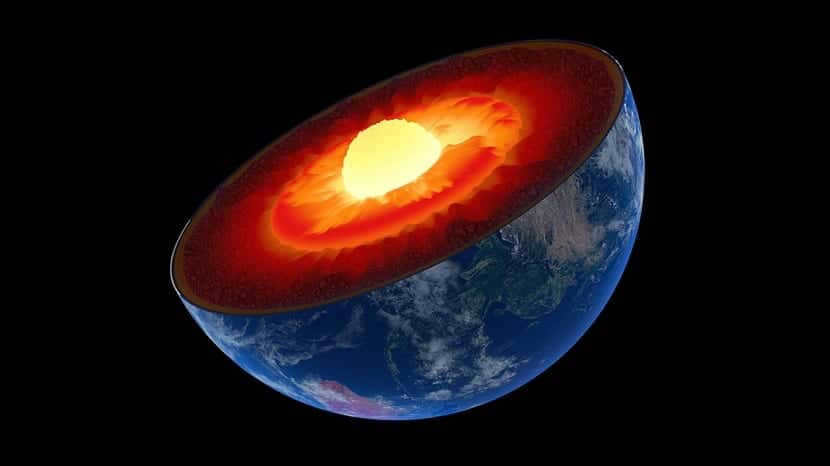
One of the notable features of the core is the utilization of radioactive materials for heat generation. When these materials decompose, they emit a substantial amount of energy, which is then converted into heat upon release. Additionally, the core is kept warm by the residual heat from the planet’s formation. Another source of heat is the transfer of heat from the liquid outer core to the solid inner core when they collide. It is important to note that the outer core is in a liquid state, while the inner core is solid.
To provide you with an understanding of the limited depth we have penetrated our planet, consider that the deepest hole reached a mere 12.3 kilometers. It is comparable to merely scratching the surface of an apple, and not even a full one at that.
The primary strata
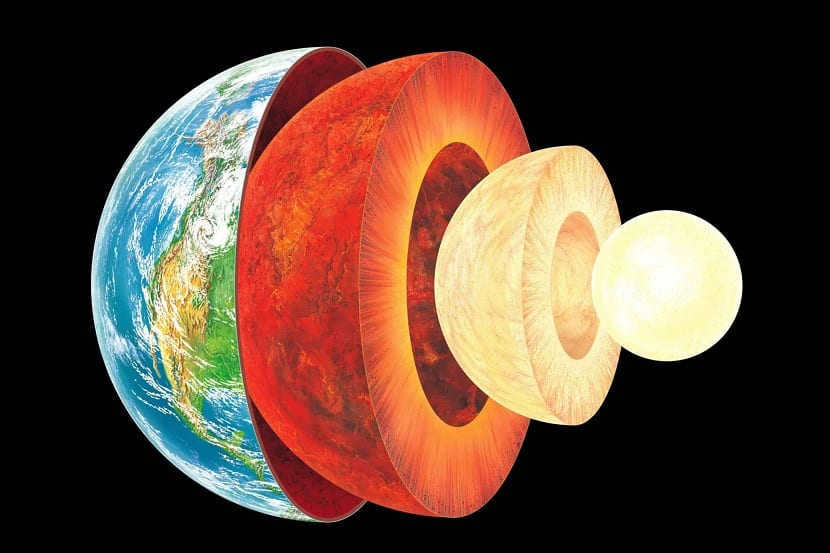
Let’s examine the primary layers in more detail.
The external core
This layer has a thickness of approximately 2,200 km and consists of liquid iron and nickel. Its temperature measures around 5,000 degrees Celsius. The liquid metal within this stratum possesses a very low viscosity, allowing for easy deformation and forging. Additionally, strong convection currents occur here, resulting in the creation of Earth’s magnetic field.
The Bullen Gap houses the most intense heat within the outer core.
This is a highly intense and compact sphere primarily composed of iron. The temperature reaches approximately 5,200 degrees Celsius. The pressure in this region is nearly 3.6 million atmospheres.
The temperature within the inner core exceeds the melting point of iron. However, it remains in a solid state. This is due to the significantly higher atmospheric pressure compared to the outer core, which prevents it from melting.
With this knowledge, scientists can further investigate the Earth’s core and its unique properties.
The information presented in this article adheres to our editorial ethics guidelines. To report any inaccuracies, please click here.
Full Article Summary: Network Meteorology ” Geology ” The Earth’s Core
Allow me to share with you the fundamental principles and the resulting consequences – upon which the entire field of geology is constructed. Frequently, those unfamiliar with the subject tend to perceive scientists as having concocted their theories out of sheer tedium and to bolster their own sense of magnificence.

On an image from 1983, the Great Atuin, elephants, and the World are depicted against the backdrop of the Universe – there won’t be anything like them
The following will be relevant to geology, but can be applied to any field of knowledge. In order to comprehend further, it is necessary to assume (at the very least) that arithmetic, Euclidean geometry, and physics/chemistry for grades 7-9 of school are accepted as reality without requiring proofs. And yes! – the Earth will be considered spherical – otherwise, it is not intriguing. Logic will also be utilized, even if it offends its adversaries.

Let’s begin with the foundation: Karl Marx Hegel. gravitational force.
"Gravity" is a film released in 2013 and directed by Alfonso Cuaron
Initially, we can simplify the Earth to a uniform sphere with a mass of M = 6*10 27 g and a radius of R = 6.37*10 8 cm.
Therefore, the energy required to transport a unit mass from the Earth’s surface to infinity (gravitational potential at the Earth’s surface) will be equivalent to:
Ug = 6.28*10 11 erg/g, where G represents the gravitational constant.
Let’s talk about our planet, Earth
Firstly, let’s consider the formation of the Earth via accretion, which involves the merging of particles from the protoplanetary disk. This process occurred simultaneously with the formation of the Solar System. I will explain the reasons behind this in more detail when discussing the age of our planet.
During the Earth’s accretion and subsequent gravitational differentiation, which involves the stratification of materials under the influence of gravity, an immense amount of energy is generated. If this energy were harnessed all at once, it would be capable of completely vaporizing several planets similar to our own. The source of this energy is the same principle that allows us to calculate gravitational potential, except in this case we gain energy through the addition of mass rather than expending it to remove mass. This energy, in the form of heat, is more than sufficient to drive the entire dynamics and evolutionary processes of the planet for many, many years to come.
Seismic (shock) waves produced by explosions (particularly underground nuclear explosions) or earthquakes are utilized to study the properties of the Earth’s interior.
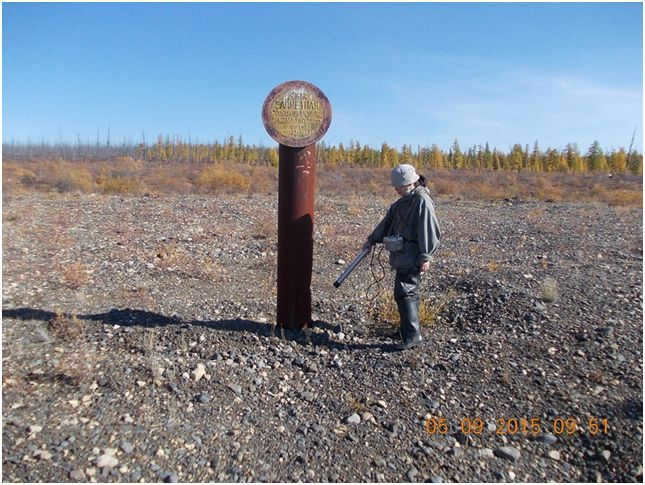
The top of a well where an atomic blast was conducted
Waves within the layers of the planet that encounter the boundaries of regions with distinct densities undergo reflection, refraction, scattering, and absorption. Detectors on the surface of the Earth capture the signals that pass through or bounce back and forth. By analyzing the data collected from detectors located worldwide and interpreting it, we are able to gain insights into the internal composition of the Earth.
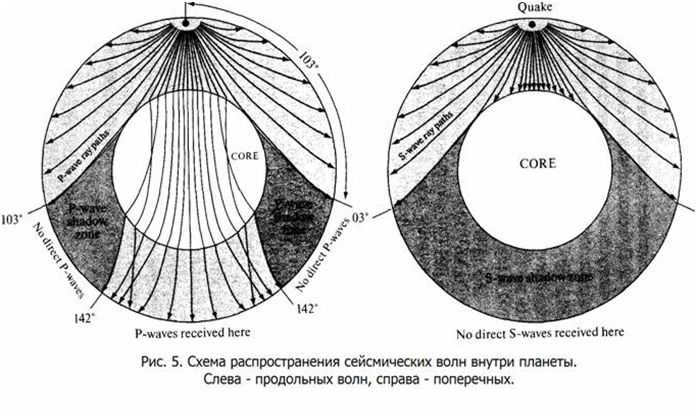
Please take note: the transverse waves (similar to ripples on a pond) emanate from the periphery of the Earth’s core. This unequivocally indicates the core’s liquid state (molten). Longitudinal waves (essentially, sound particles oscillate along the axis of propagation) are able to propagate through a liquid, as depicted in the image. The longitudinal wave, as it traverses the liquid core, does not bend at right angles, which informs us of the existence of another boundary there – the inner solid core.
In the words of my resilient nuclear engineer grandfather, “The Earth resembles a chumadan, somewhat flattened at the poles.” And he was absolutely correct! It is indeed somewhat flattened, albeit not in the conventional manner.

And here’s the evidence
We have a flattening ratio of 1: 298.25, which is slightly lower than what it would be if the Earth responded to centrifugal forces as a liquid – it would be 1:300. This becomes apparent when we consider that the Earth behaves like a highly viscous liquid and has rotated at a faster rate in the past, but it simply hasn’t had enough time to settle into its proper shape.
The faster rotation of the Earth is clearly indicated by the observed distance between the Earth and the Moon. Simply put, in the Earth-Moon system, the Moon takes away the Earth’s rotational energy through tidal interactions and uses it to move further away from us. It’s incredibly fascinating to mentally trace this process back in time – you can try it for yourself!
Measurements and their outcomes
In the early 18th century, the renowned French scientist Pierre Bouguet conducted measurements to determine the Earth’s radius in the mountainous region of Peru. Simultaneously, he sought to investigate how the mass of the mountains could affect the plumb line and potentially distort his observations of the shape of the planet. To his astonishment, Bouguet discovered that the results remained unchanged regardless of the distance from the mountain, almost as if it had no influence at all.


A colored photo showing the adjustment of the plumb line near the gravitational mass of the Leaning Tower of Pisa in 1355. This reconstruction was done in 1989.
If we take into account the findings of these measurements across the globe, it becomes evident that the weight of a vertical column with a certain cross-section remains consistent regardless of the terrain or altitude. This holds true for both oceanic and continental regions. Interestingly, a tall column of lighter rock, such as mountains, displaces a portion of denser rock (the mantle) beneath it. However, the overall weight of the column remains unchanged. This phenomenon gives rise to what is known as the “roots of mountains” – areas where the Earth’s crust thickens beneath elevated regions. It is important to note that this process does not occur instantaneously. We can observe this gradual uplift, for instance, in the Kola Peninsula and Scandinavia, where the recent retreat of a thick glacier has relieved the load, causing the Earth’s surface to gradually rise. Over time, certain locations have risen by more than a meter since the Petrovsky era.
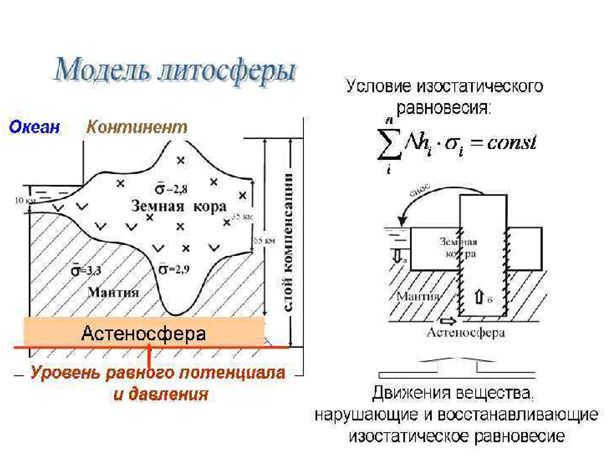
The asthenosphere is a layer in the upper part of the mantle that has a lower viscosity due to the partial melting of its substance. It covers a large portion of the Earth’s surface. Its plasticity allows for dynamic processes like plate tectonics and isostasy to occur.
Isostasy, also known as isostatic equilibrium, is a state of hydrostatic equilibrium in the Earth’s crust where a less dense crust (with an average density of 2.8 g/cm³) “floats” on a denser layer of the upper mantle called the asthenosphere (with an average density of 3.3 g/cm³), following Archimedes’ principle.
Summarizing the seismic data, we obtain a schematic representation as depicted in the school textbook:
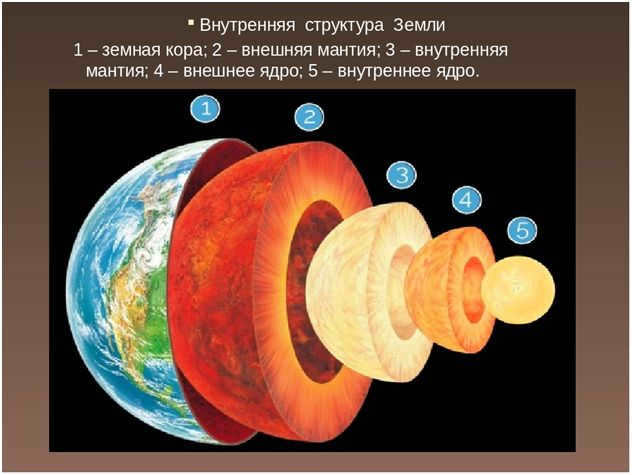
- The depth of the Earth’s crust varies from 30 to 70 km on continents and from 6 to 8 km in the oceans. It is characterized by its solid and cold nature. Below the crust lies the MOXO zone, also known as the Mohorovicich boundary, where the density of matter increases significantly.
- The mantle is composed of several layers with distinct seismic characteristics. The upper part of the mantle contains a more fluid layer called the asthenosphere. Although the mantle is solid, it is heated to a considerable extent and behaves like a thick liquid over long periods of time. The heating process is relatively uniform, indicating a mixing of matter.
- The outer core is entirely liquid and molten.
- The inner core, on the other hand, is solid and incredibly hot. However, due to the extreme pressures at that depth, it remains in a solid state and cannot become liquid.
It is evident that the Earth is not merely a spherical structure, but rather possesses a highly intricate and captivating makeup with internal dynamics. Examination of these findings indicates that the African anomaly exhibits a lower density in comparison to the Pacific anomaly, thereby suggesting that the two anomalies differ in terms of composition, dynamics, and evolutionary history.
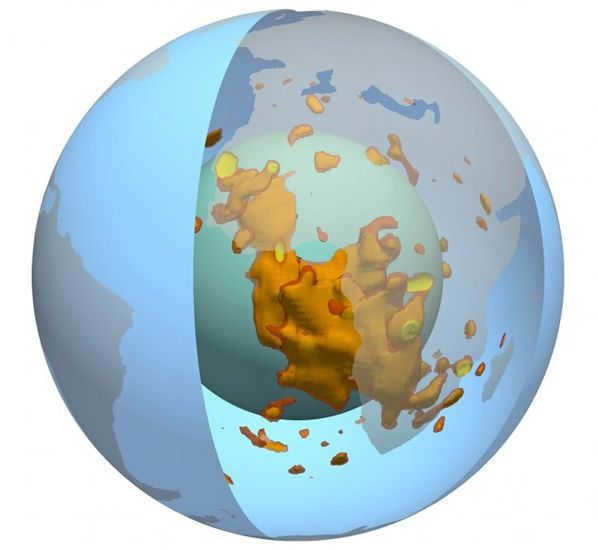
Furthermore, there exist various patterns illustrating the dispersion of seismic wave velocities:
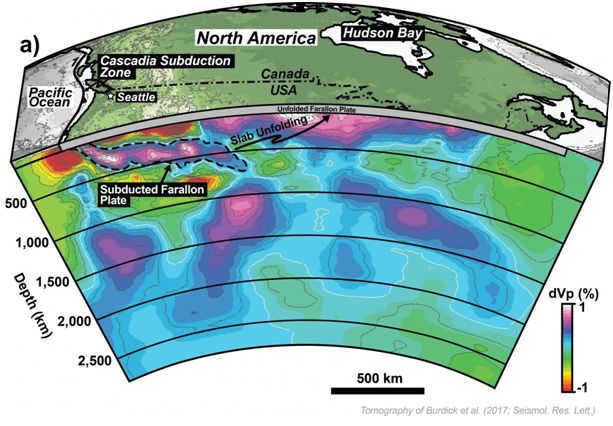
This is a very informative contribution from our colleagues in the West. In the upper left corner, it is evident how the Pacific plate is undergoing subduction beneath the continental plate.
dVp represents the disparity between the observed velocity of longitudinal waves and the calculated theoretical velocity. This discrepancy provides valuable insights into the distinct elastic properties of matter. These variations in elasticity can be attributed to changes in density caused by heating, variations in chemical composition, or substance recrystallization. Consequently, one must activate their inner geologist and determine the underlying causes and potential confirmatory evidence.
When we combine multiple images obtained from various depths, such as the ones displayed here:
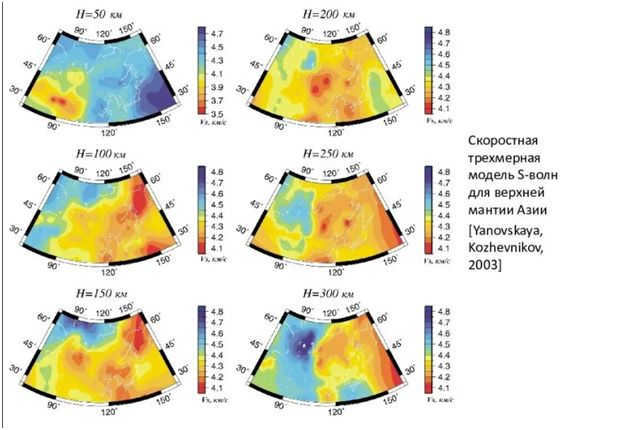
We receive a real-time volumetric representation – something akin to this:
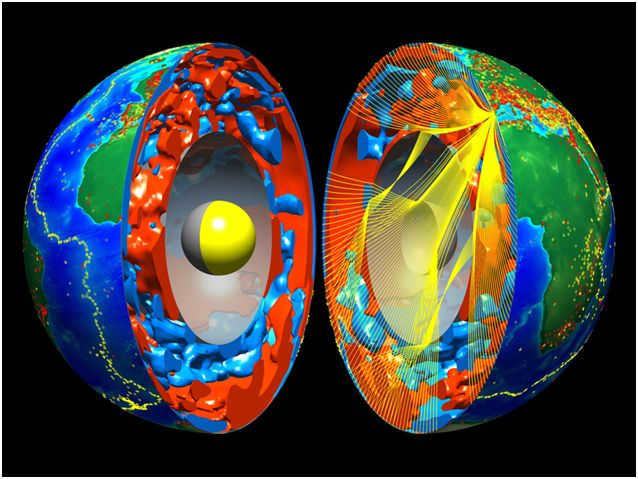
As stated earlier, we shall now engage in a discussion regarding the time it takes for a planet to form and other related concepts.

Charles Darwin reflects with sadness on the inadequate age of the Earth for his theories.
Contrarily, in 1905, Ernest Rutherford made a groundbreaking discovery by establishing the connection between radioactivity and atomic decay. This breakthrough paved the way for the development of radiometric techniques used to accurately determine the absolute age of geological formations.
An atom consists of a nucleus and electrons. The nucleus is composed of positively charged protons and uncharged neutrons. The negatively charged electrons are distributed around the nucleus. The number of protons in an atom is equivalent to its position on the periodic table, and the number of electrons matches this number as well (unless it is an ion, which is also an atom but not relevant here). However, the number of neutrons can vary. Atoms of the same chemical element that have different numbers of neutrons are called isotopes. These isotopes have the same chemical properties, but some may be radioactive while others are stable.
When a radioactive atom undergoes decay, it releases radiation in a completely unpredictable manner. However, a sample of radioactive material consisting of a large number of atoms exhibits a more predictable behavior, thanks to the precise principles of mathematical statistics and probability theory. Furthermore, the duration of time required for half of the atoms in the sample to decay, known as the half-life, is a fixed and well-known value.
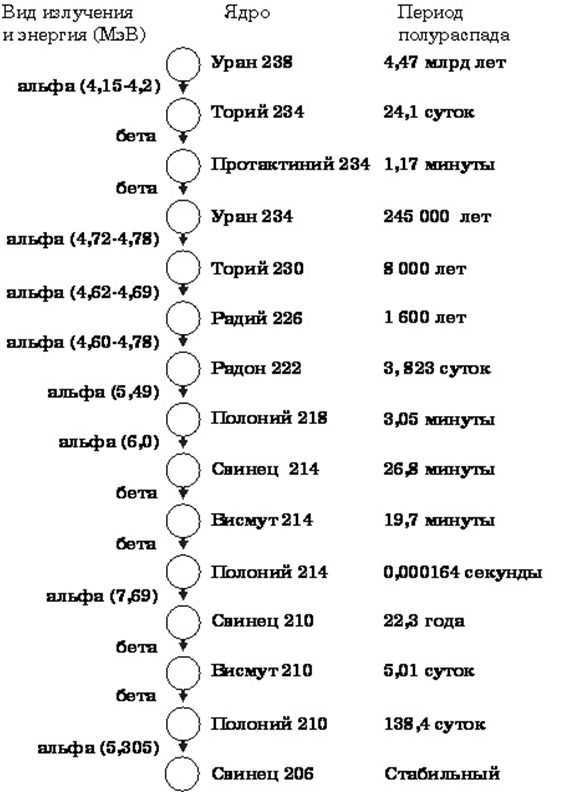
A series of atomic reactions occur during the deterioration of a uranium isotope with an atomic weight of 238 – The total number of neutrons and protons in its nucleus is 238
The resulting nuclear reactions are also predictable. By examining the composition of nuclear decay products in a material, one can accurately determine the time of its formation.
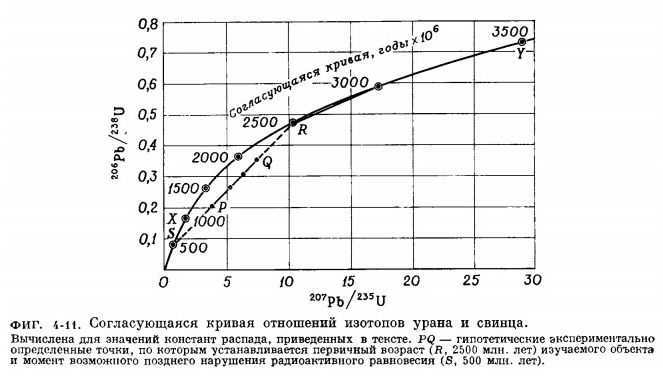
There are various methods available for comparing the amount and ratio of different elements and their isotopes obtained from various rocks.
It was quickly discovered that there are minerals on the Earth’s surface that date back at least 3.5 billion years.
Once the radioisotope methods were thoroughly understood and data was collected on the ratio of substances undergoing radioactive decay and the resulting products, analysis was conducted on meteorites, rocks from the Earth’s crust, and later samples from other planets. This revealed that:
- The Earth, along with meteorites, other planets, and the Sun, all originated from a common chaotic state. As the Earth formed from this original mixture, it naturally became homogeneous. The process of stratification released a significant amount of gravitational energy in the form of heat.
- The Earth and the rest of the solar system came into existence as separate entities approximately 4.5 billion years ago.
- The information regarding the formation of the Earth and the solar system can be found in various sources, such as the book “Earth. An Introduction to General Geology” by J. Verhoegen, F. Turner, L. Weiss, K. Warhaftig, and W. Fife, which was translated from English by Y. P. Aleshko-Ozhevsky, R. M. Mineeva, G. N. Mukhitdinov, and P. P. Smolin and published by “MIR” in 1974.
- Another source that provides insights into this topic is the book “Geodynamics” by S.V. Aplonov, published by the Publishing house of St. Petersburg University in 2001.
- For more specific geological terminology, the “Geological Dictionary” published by “NEDRA” in 1973 can be consulted.
- Additionally, recent research published on www.nature.com on March 10, 2022, titled “Instability of the African large low-shear-wave-velocity province due to its low intrinsic density,” offers further understanding of the Earth’s geological dynamics.
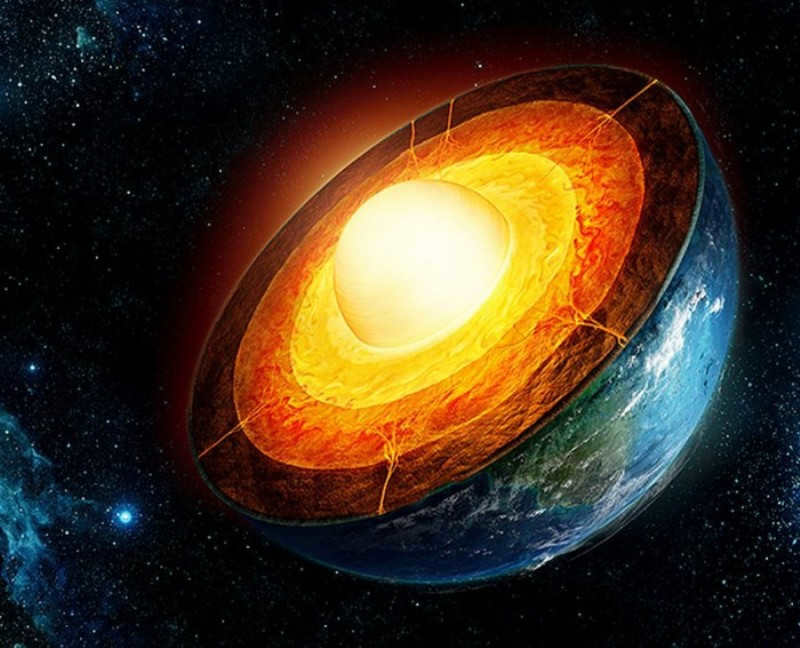
Deep inside every celestial body that has managed to attain a spherical shape resides a core – sometimes not just a simple core, but a multi-layered core. At immense depths, even the most familiar substances like iron exhibit extraordinary properties – transforming into enormous crystals, transitioning into a liquid state, or generating electrical currents. The Earth’s outer and inner core impeccably exemplify all of these peculiarities – and it was also the very first nurturer of life on our planet.
The Path to the Heart
Exploring the Earth’s core is no easy task – there is a 2,900 kilometer gap between the surface and the uppermost layer. Drilling to such depths presents numerous challenges – as you descend further underground, the temperature steadily rises. In the Kola well, the deepest known drill hole, temperatures reached a scorching 220°C at a depth of 12 kilometers! Such extreme temperatures make it difficult for both electronics and equipment to function properly – everything must be carefully lowered into the well and then retrieved.
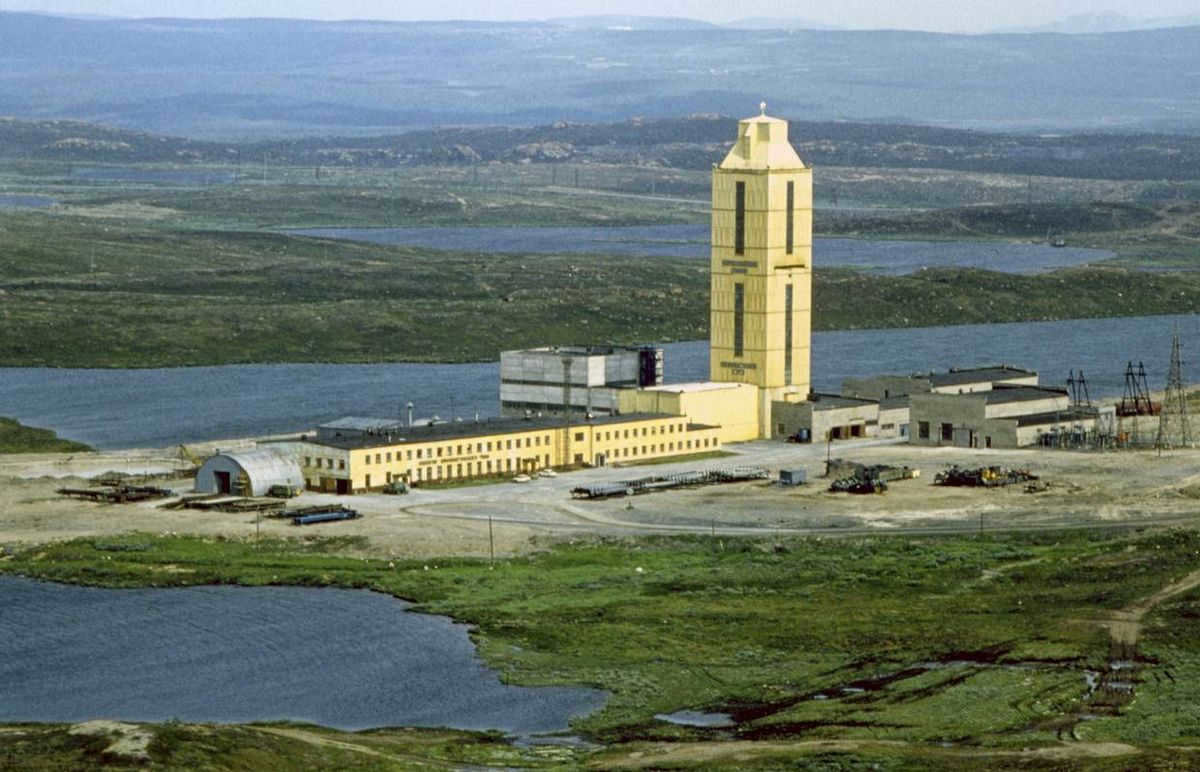
The Kola ultra-deep well
However, even after surpassing the lithosphere, there remains the challenge of penetrating the hot plastic mantle. During the 2000s, a project was devised to enable a small melon-sized probe to reach the Earth’s core. Admittedly, the plan had a few drawbacks – it required detonating multiple nuclear bombs, pouring molten metal into the core, and creating a material capable of enduring temperatures of 2-3 thousand degrees Celsius! Nevertheless, on paper, the project seemed remarkable: the probe would be able to traverse the distance to the Earth’s core in just one week, accompanied by a stream of scorching hot iron.
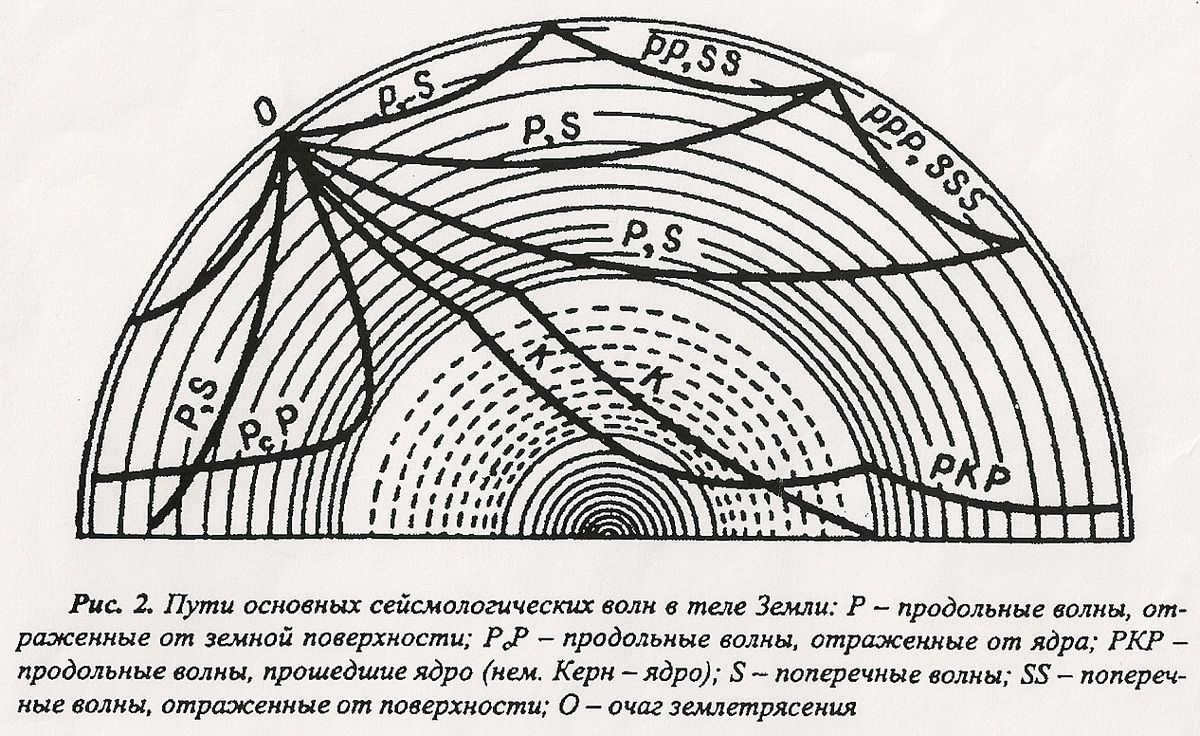
A diagram illustrating the movement of seismic waves within the Earth’s interior
Geologists also rely on various indirect indicators. For instance, monitoring the Earth’s magnetic field enables scientists to monitor the core’s rotational dynamics. Surprisingly, even unexpected sources can provide valuable insights into the depths. A notable example occurred when malfunctions in the Hubble space telescope allowed researchers to detect alterations in the flow patterns within the Earth’s liquid outer core, which are responsible for magnetic pole shifts.
Structure and properties of the Earth’s core
The journey to acquire knowledge is arduous and challenging, but the rewards it brings are truly satisfying. Currently, we have reliable information about the physical characteristics of the Earth’s core:
- The core of the Earth can reach temperatures of up to 6000 degrees Celsius at its center, which is comparable to the surface temperature of the Sun. However, unlike the Sun, the core’s heat is not generated by nuclear reactions but rather by the force of gravity. Specifically, the immense pressure in the core, which is 3.5 million times greater than atmospheric pressure, amounts to 360 gigapascals. Although there are atomic decay processes occurring deep within the Earth, their contribution to the overall heat production is relatively small. Without the tremendous compression exerted on the core, these processes would be sluggish and less efficient.
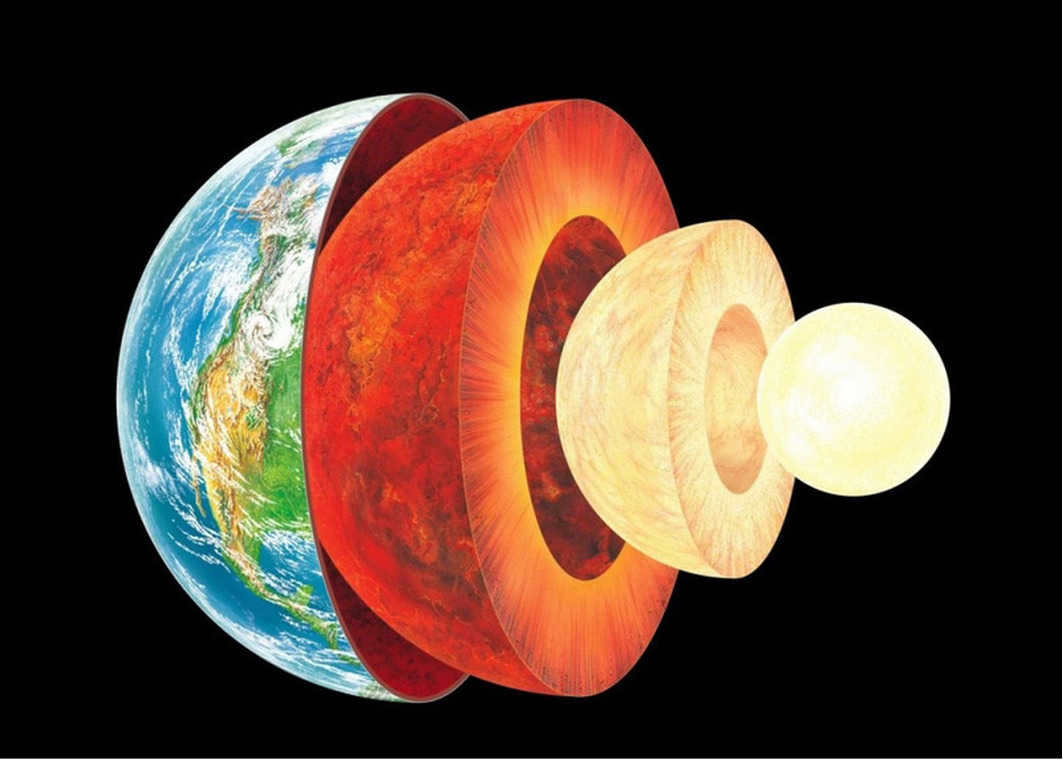
The Earth’s classical fundamental spheres
- The Earth’s core measures 7000 kilometers in diameter – larger than both the Moon and Mars! It occupies a relatively small portion of the Earth’s interior – about 15% of its volume – but its mass, 1.932 × 10 24 kilograms, accounts for 30% of the total mass of the Earth.
- Interestingly, the various layers of the core rotate in different directions. Currently, it is believed that the outer liquid core rotates from east to west around its axis, while the inner core rotates from west to east and at a faster rate than the Earth. However, the difference is not very significant – over the course of a year, it is only a quarter of a degree ahead of the planet.
Furthermore, recent studies indicate that there exists an additional layer within the inner core of the Earth, known as the “extremely” inner core, which rotates on a distinct axis. Let us examine this layer and the other constituents of the Earth’s core more closely.
The innermost core
The initial stratum of the core, which directly interfaces with the mantle, is referred to as the outer core. Its upper limit is situated approximately 2.3 thousand kilometers beneath sea level, while its lower limit lies at a depth of 2900 kilometers. In terms of composition, it is indistinguishable from the underlying layers – the intense gravitational pressure prevents the molten metal from solidifying. Nevertheless, the fact that it remains in a liquid state distinguishes Earth from the other inner planets within the solar system.
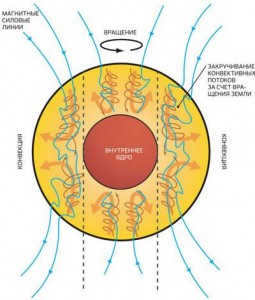
The liquid part of the Earth’s core is responsible for generating its magnetic field. This magnetic field, known as the magnetosphere, acts as a protective shield against charged particles from outer space and the solar wind. These particles are even more hazardous than radiation, as they can disrupt not only living organisms but also electronics. Biologists hypothesize that an active magnetic field played a crucial role in the survival of early single-celled organisms.
The core’s innermost layer
Within the fluid shell lies the core’s innermost layer. It consists of a solid mass with a diameter of 1220 kilometers, equivalent to the size of Charon, Pluto’s satellite. This section of the core exhibits high density, with an average matter concentration of 12.8-13g/cm 3, twice as dense as iron, and extreme heat, reaching temperatures of 5-6 thousand degrees Celsius.
The immense pressure at the core of the Earth leads to the solidification of metal at temperatures surpassing its boiling point. This results in the creation of extraordinary crystals that showcase exceptional stability even under typical circumstances. Experts hypothesize that the inner core consists of an array of iron and nickel crystals that stretch for several kilometers and align in a north-south direction. To validate this theory, a team of Japanese researchers dedicated a decade to fabricating a unique diamond anvil capable of replicating the extreme pressure and temperature found at the heart of our planet.

The “inner” core within the core, or a hypothetical matryoshka doll
During the initial examination of the Earth’s core using seismic waves, geologists observed an unusual deviation of vibrations from east to west. Initially, this went unnoticed due to the Earth’s wider equator compared to its poles caused by rotation. However, further investigation revealed the possibility of an additional shell within the central part of the core.
What exactly is the “inner” inner core? It is believed that it consists of the same metallic crystals, but with a different orientation – facing west instead of north. The cause of this stratification is still unknown. However, the alignment of the crystals suggests that gravitational interactions with celestial bodies such as the Sun or Moon play a role.
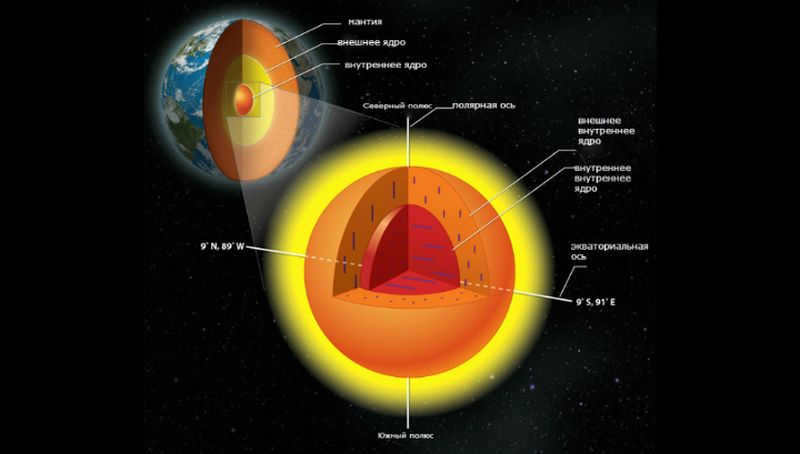
“Inner” core within the Earth’s structure
Formation mechanism of the core
Every celestial body in our solar system possesses a core, whether it be a full-fledged planet or a dwarf planet, ranging from the awe-inspiring gas giant Jupiter to the distant and frigid Sedna. The characteristics of these cores differ from one object to another – for instance, Mercury’s core accounts for 60% of the planet’s mass and 80% of its volume, whereas the Moon’s core has a modest radius of 350 kilometers compared to the satellite’s total radius of 1735 kilometers.
However, the formation of the nucleus of any celestial body, including a star, is influenced by a fascinating gravitational phenomenon known as interior differentiation. When planets are in their early stages of formation from gas clouds surrounding a young star, their material accumulates around primary nuclei such as large rocks, clusters of ice, or dust. As the young planet accumulates sufficient mass, gravity becomes a dominant force, causing heavy elements like iron to be pulled towards the center of the object, while lighter substances like silicon or oxygen are pushed towards the surface.
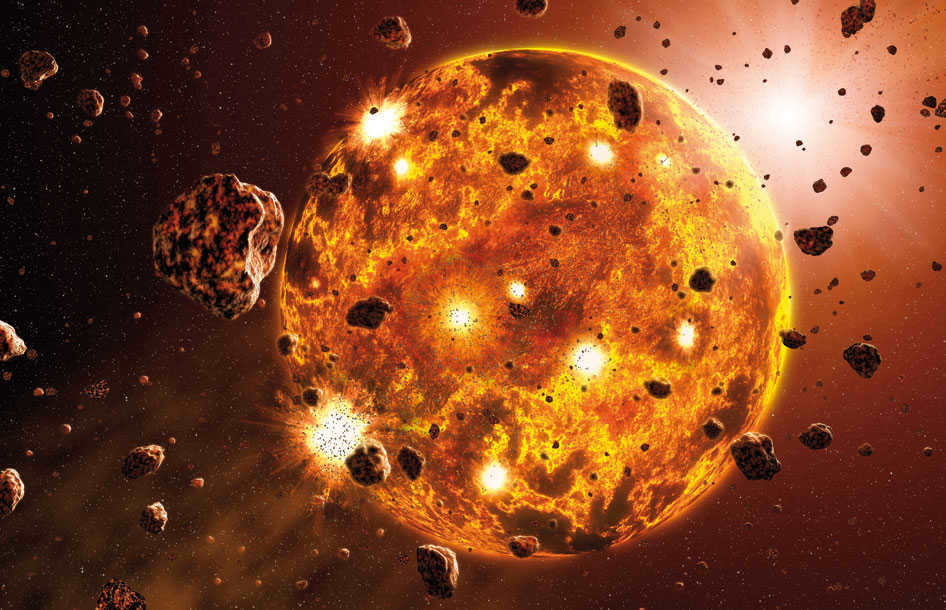

The image depicts the Earth in the midst of active accretion, as portrayed by the artist.
During these movements, a vast amount of energy is released, resulting in the planet undergoing melting, and its gravity causing it to assume a distinctive spherical shape. This acceleration facilitates the movement of heavy matter. Asteroids that lack sufficient mass to melt remain as conglomerates of dust and rocks that have collided with one another.
- It’s fascinating to note that despite being one of the heaviest elements found in nature, uranium defied the process of differentiation and remained predominantly on the Earth’s surface, specifically in the Earth’s crust. The reason behind this phenomenon is that uranium only occurs in association with lighter elements, which acted as its “lifeline” and prevented it from sinking deeper.
On the other hand, all the heavier elements, such as iron and nickel, descended deeper into the Earth and formed the planet’s core. The Earth’s core has undergone a remarkable journey, starting from the dust swirling around the young Sun and transforming into a multi-layered metallic sphere. Today, it provides warmth and protection to our planet from within.

The Earth’s size appears unbelievably vast to us, its inhabitants. In reality, our planet is one of the smallest in the solar system. Only Mars, Mercury, and Venus have smaller sizes than it. However, Venus is only slightly smaller in size.
Physical attributes
It is now widely known that the Earth has a spherical shape. This fact has been proven through photographs and numerous studies. However, it is not a perfect sphere, but rather a geoid – a slightly more intricate figure that sets it apart from the shapes of other planets in the solar system.
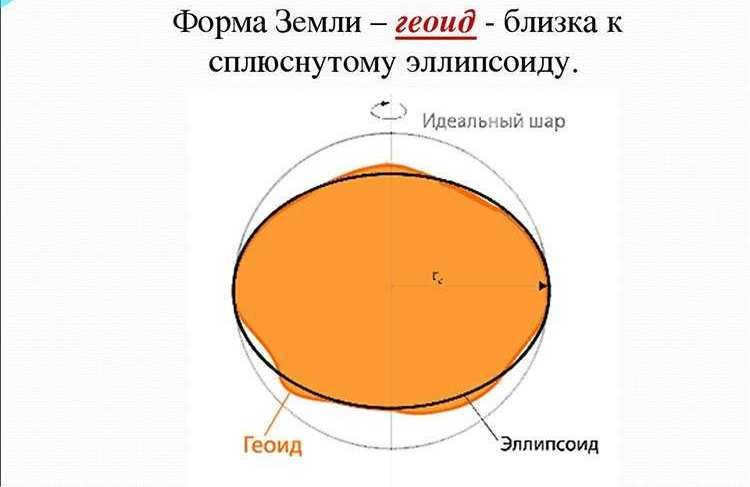
While our neighboring planets are perfect spheres, the Earth has a slightly flattened shape at its poles. This is due to the mass of the planet being concentrated towards its center, causing the equatorial and polar diameters to differ. In fact, the equatorial diameter is 43 kilometers larger than the polar diameter.
The Earth can be described by the following measurements:
- Diameter: The equatorial diameter is 12,742 kilometers, while the polar diameter measures 12,699 kilometers.
- Circumference: The meridian of the Earth measures approximately 40,000 kilometers (or more precisely, about 40,007 kilometers). The exact value is slightly different due to the historical definition of a meter, which was defined as one ten millionth of the distance from the equator to the north pole through Paris. However, this definition resulted in a meter standard that was slightly shorter than the actual distance by about 0.2 mm. The length of the equator, on the other hand, is 40,075 kilometers, providing further evidence of the Earth’s oblate shape. This compression at the poles also leads to a slightly stronger gravitational force there (about a hundredth stronger, although not perceptible).
- Mass: The Earth has a mass of approximately 5.9736 *10 24 kg, a characteristic that was determined using Newton’s classical theory of gravitation.
- Volume: The volume of the Earth is approximately 10.8321*10 11 km 3 , which has been accurately measured with the aid of satellite technology. In the past, ancient Greek scientists attempted to calculate this volume through manual calculations, and surprisingly, their estimates were fairly accurate. However, with the advancement of technology, we are now able to determine the exact value of the Earth’s volume.
- Area: The Earth’s surface is predominantly covered by water, with approximately 80% of its total area being water. The remaining area is land, which accounts for less than a third of the planet’s surface. However, this ratio is constantly changing due to factors such as melting glaciers and the drying of rivers that supply water to the seas. Overall, the Earth’s surface spans over 510 million square kilometers.
- Density: The average density of the Earth is approximately 5.5153 g/cm 3 . This property, along with mass, is derived from Newton’s classical theory of gravitation.
Size of the central region
The central region of the Earth is located approximately 2900 km beneath the surface. Scientists have determined the properties and dimensions of this region, including its composition, by studying volcanic activity and seismic events. The average diameter of the Earth’s central region is estimated to be 3,485 kilometers. It is divided into two distinct layers: a solid inner core and a liquid outer core. The inner core has a thickness of around 1300 km, while the outer core measures approximately 2200 km in thickness.
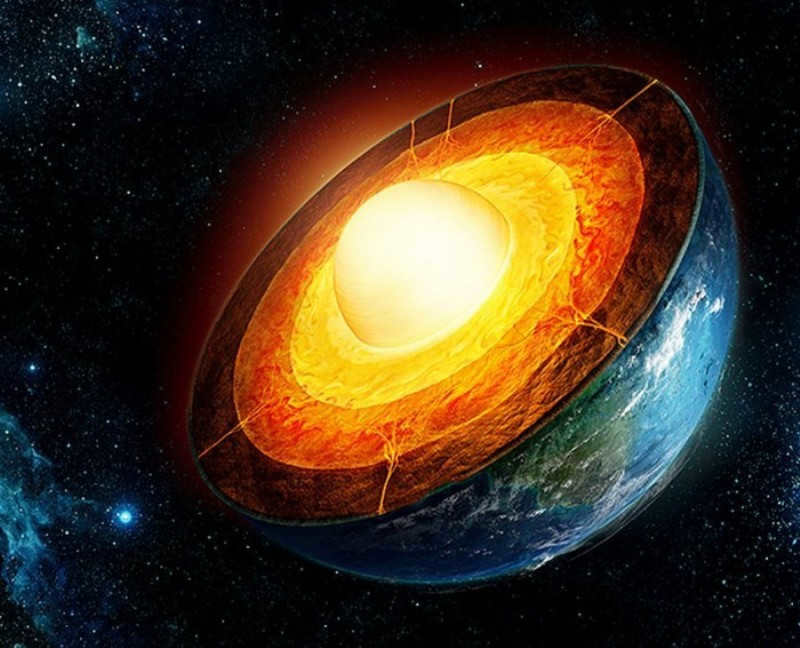
Earth’s Magnetic Field
The magnetic field of the Earth is in the form of a dipole, with its poles located near the planet’s geographic poles. This magnetic field plays a crucial role in protecting the Earth from the harmful effects of solar radiation. Without it, all forms of life on our planet would have perished a long time ago.
